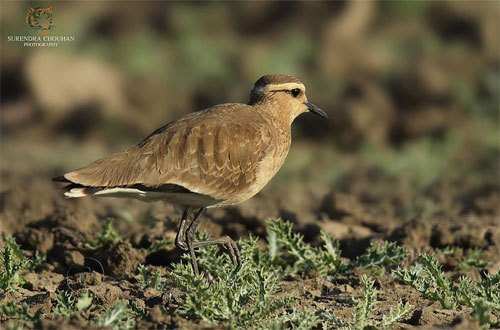Critically endangered wader sighted at Jawai Dam
On Sunday 10th January 2016 Surendra Chouhan sighted & photograph a critically endangered wader from lapwing family at Jawai Dam, Pali, Rajasthan.

On Sunday 10th January 2016 Surendra Chouhan sighted & photograph a critically endangered wader from lapwing family at Jawai Dam, Pali, Rajasthan.
Medium sized lapwing wader has black legs with small black beak.
This attractive medium-sized lapwing has longish black legs and a short black bill. Summer adults have grey backs and breast, dark belly and white undertail. The head has a striking pattern, with a black crown and eyestripe, the latter being bordered above and below with white. The upper neck is ochre.
Its longish black legs, white tail with a black terminal band and distinctive brown, white and grey wings make it almost unmistakable in flight. Length is 27–30 cm (11–12 in).Winter adults have a less distinct head pattern, slightly browner back and breast, and white belly. Young birds have a scaly back and only traces of the head pattern.This species breeds on open grassland in Russia and Kazakhstan. Three to four eggs are laid in a ground nest. These birds migrate south through Kyrgyzstan, Tajikistan, Uzbekistan, Turkmenistan, Afghanistan, Armenia, Iran, Iraq, Saudi Arabia, Syria and Turkey, to key wintering sites in Israel, Syria, Eritrea, Sudan and north-west India. Birds winter occasionally in Pakistan, Sri Lanka and Oman. It is a very rare vagrant in western and northern Europe, where this gregarious bird is usually found with northern lapwings.
It feeds in a similar way, picking insects and other small prey mainly from grassland or arable land.In 2004, BirdLife International categorized this bird as critically endangered, due to a very rapid population decline for poorly understood reasons. The main decline took place between 1960 and 1987, when the known population halved; it is some 20–25% of the 1930s population levels.
The current population was estimated to be between 600 and 1,800 mature birds in 2006,but is being revised to the upward end of that scale, possibly more, following the discovery of the species’ previously unknown main wintering grounds in Syria, where 1500 birds of all ages were encountered.Additionally, in October 2007, a superflock of approximately 3,200 sociable lapwings were discovered in Turkey, according to Guven Eken, director of the Turkish Nature Association.The current IUCN classification is CR A3bc—meaning that the population is expected to decline in the next decade or so by 80%, but based on theoretical considerations and the known habitat destruction rather than direct observation of the birds. Thus, the new discoveries might mean that as more data becomes available, the species could be downlisted to Endangered.
To join us on Facebook Click Here and Subscribe to UdaipurTimes Broadcast channels on GoogleNews | Telegram | Signal


